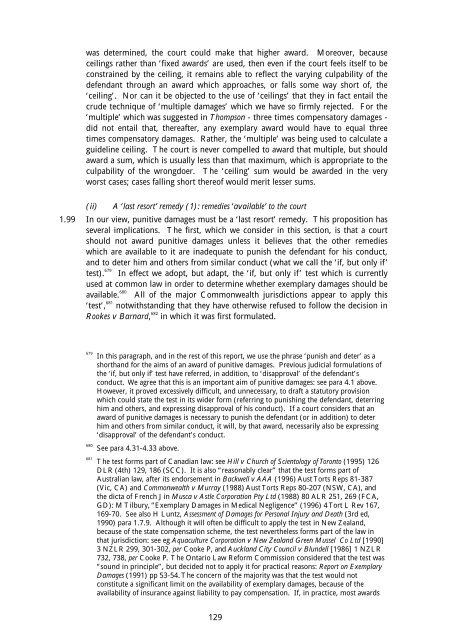Aggravated, Exemplary and Restitutionary ... - Law Commission
Aggravated, Exemplary and Restitutionary ... - Law Commission
Aggravated, Exemplary and Restitutionary ... - Law Commission
You also want an ePaper? Increase the reach of your titles
YUMPU automatically turns print PDFs into web optimized ePapers that Google loves.
was determined, the court could make that higher award. Moreover, because<br />
ceilings rather than ‘fixed awards’ are used, then even if the court feels itself to be<br />
constrained by the ceiling, it remains able to reflect the varying culpability of the<br />
defendant through an award which approaches, or falls some way short of, the<br />
‘ceiling’. Nor can it be objected to the use of ‘ceilings’ that they in fact entail the<br />
crude technique of ‘multiple damages’ which we have so firmly rejected. For the<br />
‘multiple’ which was suggested in Thompson - three times compensatory damages -<br />
did not entail that, thereafter, any exemplary award would have to equal three<br />
times compensatory damages. Rather, the ‘multiple’ was being used to calculate a<br />
guideline ceiling. The court is never compelled to award that multiple, but should<br />
award a sum, which is usually less than that maximum, which is appropriate to the<br />
culpability of the wrongdoer. The ‘ceiling’ sum would be awarded in the very<br />
worst cases; cases falling short thereof would merit lesser sums.<br />
(ii) A ‘last resort’ remedy (1): remedies ‘available’ to the court<br />
1.99 In our view, punitive damages must be a ‘last resort’ remedy. This proposition has<br />
several implications. The first, which we consider in this section, is that a court<br />
should not award punitive damages unless it believes that the other remedies<br />
which are available to it are inadequate to punish the defendant for his conduct,<br />
<strong>and</strong> to deter him <strong>and</strong> others from similar conduct (what we call the ‘if, but only if’<br />
test). 679<br />
In effect we adopt, but adapt, the ‘if, but only if’ test which is currently<br />
used at common law in order to determine whether exemplary damages should be<br />
available. 680<br />
All of the major Commonwealth jurisdictions appear to apply this<br />
‘test’, 681<br />
notwithst<strong>and</strong>ing that they have otherwise refused to follow the decision in<br />
Rookes v Barnard, 682<br />
in which it was first formulated.<br />
679 In this paragraph, <strong>and</strong> in the rest of this report, we use the phrase ‘punish <strong>and</strong> deter’ as a<br />
shorth<strong>and</strong> for the aims of an award of punitive damages. Previous judicial formulations of<br />
the ‘if, but only if’ test have referred, in addition, to ‘disapproval’ of the defendant’s<br />
conduct. We agree that this is an important aim of punitive damages: see para 4.1 above.<br />
However, it proved excessively difficult, <strong>and</strong> unnecessary, to draft a statutory provision<br />
which could state the test in its wider form (referring to punishing the defendant, deterring<br />
him <strong>and</strong> others, <strong>and</strong> expressing disapproval of his conduct). If a court considers that an<br />
award of punitive damages is necessary to punish the defendant (or in addition) to deter<br />
him <strong>and</strong> others from similar conduct, it will, by that award, necessarily also be expressing<br />
‘disapproval’ of the defendant’s conduct.<br />
680 See para 4.31-4.33 above.<br />
681 The test forms part of Canadian law: see Hill v Church of Scientology of Toronto (1995) 126<br />
DLR (4th) 129, 186 (SCC). It is also “reasonably clear” that the test forms part of<br />
Australian law, after its endorsement in Backwell v AAA (1996) Aust Torts Reps 81-387<br />
(Vic, CA) <strong>and</strong> Commonwealth v Murray (1988) Aust Torts Reps 80-207 (NSW, CA), <strong>and</strong><br />
the dicta of French J in Musca v Astle Corporation Pty Ltd (1988) 80 ALR 251, 269 (FCA,<br />
GD): M Tilbury, “<strong>Exemplary</strong> Damages in Medical Negligence” (1996) 4 Tort L Rev 167,<br />
169-70. See also H Luntz, Assessment of Damages for Personal Injury <strong>and</strong> Death (3rd ed,<br />
1990) para 1.7.9. Although it will often be difficult to apply the test in New Zeal<strong>and</strong>,<br />
because of the state compensation scheme, the test nevertheless forms part of the law in<br />
that jurisdiction: see eg Aquaculture Corporation v New Zeal<strong>and</strong> Green Mussel Co Ltd [1990]<br />
3 NZLR 299, 301-302, per Cooke P, <strong>and</strong> Auckl<strong>and</strong> City Council v Blundell [1986] 1 NZLR<br />
732, 738, per Cooke P. The Ontario <strong>Law</strong> Reform <strong>Commission</strong> considered that the test was<br />
“sound in principle”, but decided not to apply it for practical reasons: Report on <strong>Exemplary</strong><br />
Damages (1991) pp 53-54. The concern of the majority was that the test would not<br />
constitute a significant limit on the availability of exemplary damages, because of the<br />
availability of insurance against liability to pay compensation. If, in practice, most awards<br />
129
















